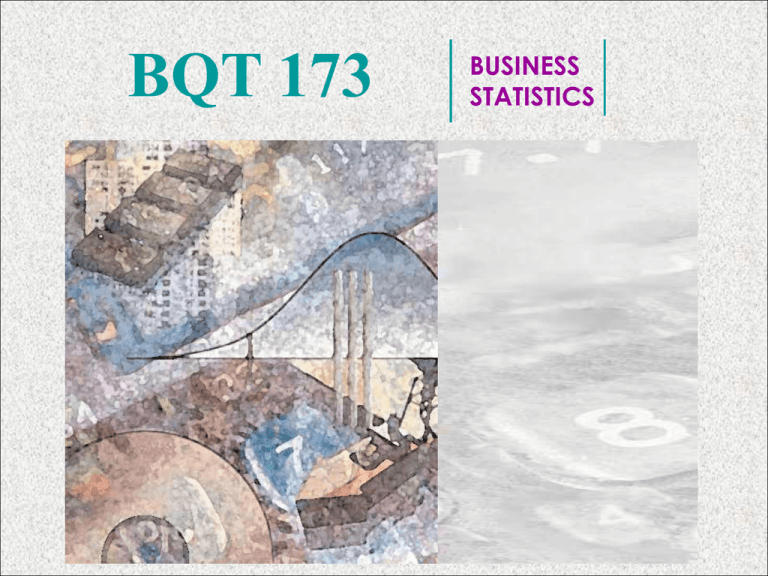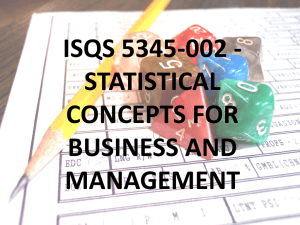Practical Business Statistics
advertisement

1-1 BQT 173 Irwin/McGraw-Hill BUSINESS STATISTICS © Andrew F. Siegel, 1997 and 2000 1-2 l BQT 173l Business Statistics CHAPTER 1 The role of Statistical Thinking in Business CHAPTER 2 Statistical Concepts and Language CHAPTER 3 Exploration Data Analysis CHAPTER 4 Introduction to Statistical Software Package CHAPTER 5 Discrete Probability Distributions Irwin/McGraw-Hill © Andrew F. Siegel, 1997 and 2000 1-3 l BQT 173l Business Statistics CHAPTER 6 Continuous Probability Distributions CHAPTER 7 Hypothesis Tests CHAPTER 8 Analysis of Variance CHAPTER 9 Simple Linear Regression CHAPTER 10 Non-Parameteric Statistics CHAPTER 11 Time Series And Business Forecasting Irwin/McGraw-Hill © Andrew F. Siegel, 1997 and 2000 1-4 l Chapter 1 l The role of Statistical Thinking in Business 1.1 Component of Statistical Thinking 1.2 Definition of Business Statistics 1.3 Descriptive and Inferential Statistics 1.4 Ethical Issues in Statistical Data Analysis Irwin/McGraw-Hill © Andrew F. Siegel, 1997 and 2000 1-5 1.1 Component of Statistical Thinking Statistical thinking is the philosophy of learning and action based on the following fundamental principles: 1. 2. 3. all work occurs in a system of interconnected processes - a process being a chain of activities that turns inputs into outputs; variation, which gives rise to uncertainty, exists in all processes; and understanding and reducing variation are keys to success. Irwin/McGraw-Hill © Andrew F. Siegel, 1997 and 2000 1-6 1.2 Definition of Business Statistics In the business world, statistics has these important specific uses: To summarize business data To draw conclusions from those data To make reliable forecasts about business activities To improve business processes Irwin/McGraw-Hill © Andrew F. Siegel, 1997 and 2000 1-7 1.3 Descriptive and Inferential Statistics The statistical methods you use for these tasks come from one of the two branches of statistics: DESCRIPTIVE STATISTICS Descriptive statistics are the methods that help collect, summarize, present, and analyze a set of data. INFERENTIAL STATISTICS Inferential statistics are the methods that use the data collected from a small group to draw conclusions about a larger group. Irwin/McGraw-Hill © Andrew F. Siegel, 1997 and 2000 1-8 1.3 Descriptive and Inferential Statistics There are four important uses of statistics in business: To visualize and summarize your data (using descriptive methods) To reach conclusions about a large group based on data collected from a small group (using inferential methods) To make reliable forecasts that are based on statistical models for prediction (inferential methods) Irwin/McGraw-Hill © Andrew F. Siegel, 1997 and 2000 1-9 1.4 Ethical Issues in Statistical Data Analysis There are a number of possible ways in which unethical behavior can arise in statistics and researchers should steer clear of these. It is relatively simple to manipulate and hide data, projecting only what one desires and not what the numbers actually speak. Irwin/McGraw-Hill © Andrew F. Siegel, 1997 and 2000 1-10 1.4 Ethical Issues in Statistical Data Analysis E.g 1: Data collection can be made inherently biased by posing the wrong questions that stimulate strong emotions rather than objective realities. This happens all the time when the survey is aimed to try and prove a viewpoint rather than find out the truth. Irwin/McGraw-Hill © Andrew F. Siegel, 1997 and 2000 1-11 1.4 Ethical Issues in Statistical Data Analysis E.g 2: Scientists not including data outliers in their report and analysis to validate their theory or viewpoint. This happens both in pure and social sciences. By obscuring data or taking only the data points that reinforce a particular theory, scientists are indulging in unethical behavior. Irwin/McGraw-Hill © Andrew F. Siegel, 1997 and 2000 1-12 1.4 Ethical Issues in Statistical Data Analysis E.g 3: After a broad survey of many customers, a company might decide to publish and make available only the numbers and figures that reflect well on the company and either totally neglect or not give due importance to other figures. Irwin/McGraw-Hill © Andrew F. Siegel, 1997 and 2000 1-13 1.4 Ethical Issues in Statistical Data Analysis E.g 3: After a broad survey of many customers, a company might decide to publish and make available only the numbers and figures that reflect well on the company and either totally neglect or not give due importance to other figures. Irwin/McGraw-Hill © Andrew F. Siegel, 1997 and 2000 1-14 1.4 Ethical Issues in Statistical Data Analysis E.g 3 (Cont.): A car might be ranked high on comfort but low on safety. By showing only the comfort figures for the car, the company is, in a way, misleading customers and shareholders about the real picture. Irwin/McGraw-Hill © Andrew F. Siegel, 1997 and 2000 1-15 1.4 Ethical Issues in Statistical Data Analysis Surveys and polls often indulge in unethical behavior to reinforce a viewpoint. For example, a survey might not reflect true public opinion because it is not statistically significant. However, many surveys do not publish this along with their poll and this can be misleading. Irwin/McGraw-Hill © Andrew F. Siegel, 1997 and 2000




